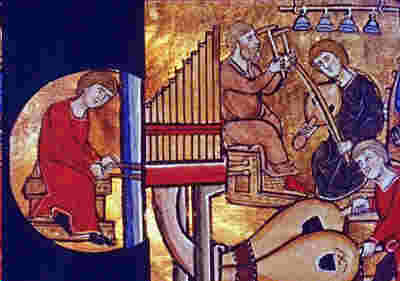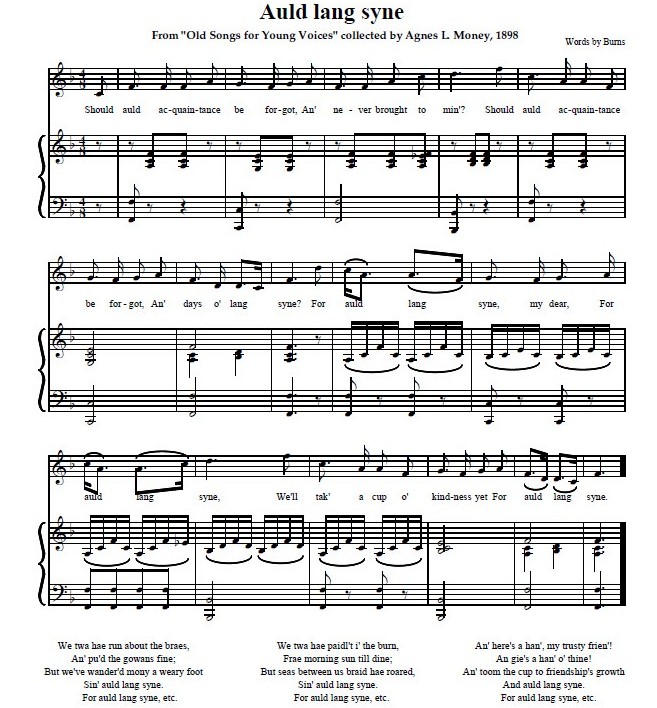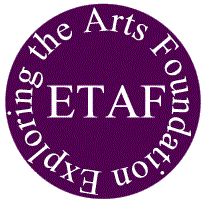
western Musical notation—Page 3
broad characteristics of Modern Western Musical notation
Up to now, The Muse has explored the general character of modern Western
notation systems. Here, The Muse describes the basic and most essential
elements of the Western music notation system as they
might appear on a typical, specific piece of Western music. This is a fundamental
exposition; the subject is too large and complex to treat in this venue in
its entirety.
The Muse begins this exploration with an examination of a specific score. Below is the score of the famous traditional popular melody,
Auld lang syne,
from Old Songs for Young Voices, collected by Agnes L. Money and
published 1898. Words are from the immortal poem by Robert (Bobby or Rabbie) Burns. This score exhibits a moderate amount of notational
complexity.
To help clarify the
connection between Western notation and Western music, The Muse suggests that take
the following steps:
- Click the image of the media player below to listen to Auld lang
syne.
- As the music plays, follow the lyrics on the page of sheet music below.
- Now, play the song again while you read the description of Western
notation that follows the score (below on this page). Look for notations on the score that
correspond to points made about notation in the description of Western
notation, below.
- Check back and forth between the notation description and the score
until you are satisfied that you understand the connection between what
you're hearing, seeing on the score, and reading about the description.
Play the song as many times as you need.
—play the Jean Redpath version of the song
now—
|
|
—tip— viewing & Listening options
As you read about Western notation and listen to the music, you may find it
difficult to make comparisons between what you read about Western notation
and the score because you can't see both of them on your computer monitor at
the same time. Or score notation or lyrics may be too small to see clearly. You may find it
necessary to scroll up and down between them repeatedly.
If you are reading this on a computer equipped with a large monitor or
more than one monitor, you have the option to reduce or eliminate these
difficulties by opening the score in a new window and arranging
it on your monitor.
It helps to minimize your media player
so it doesn't block your view. |

Description of Western Notation
—play the Jean Redpath version of the song
again—
About Auld lang syne Notation—General
- Modern Western notation uses a five-line staff on a page of music, one line
under another, to provide a field on which to represent music that is to be played or read. Pitch is
indicated by placement of notes on the staff and duration is shown with
different note values and additional symbols such as dots and ties.
- Notation on a staff is read from left to right and top to bottom.
- A staff of written music normally begins with a clef, which indicates
the particular range of pitches encompassed by the staff. Notes
representing a pitch outside of the scope of the standard five line staff
are represented using ledger lines, which display a single note with
additional lines and spaces.
- Unless otherwise indicated, the key signature follows clef on the
staff. It indicates the key of a piece by specifying certain notes to be
flat or sharp throughout the piece.
- A time signature is next, following the key signature.
- Measures (spaces between vertical bars) divide the piece into regular groupings of beats, and
the time signatures specify these groupings.
- If needed, text directions to musicians, called markings, are placed above or below the staff
wherever they
are needed. Markings are usually derived from standard
Western notation musical nomenclature. They specify such items as tempo, dynamics, and other musical characteristics
the composer wants to achieve.
About Auld lang syne Notation—Details
- This sheet music is arranged for piano. It contains three rows of three staves each. Top stave
contains the vocal or melody line. Center stave contains chords to be
played with the right hand. Third stave contains chords to be played with
the left hand.
- Top and center staves in each row each contain a treble clef at the
left. Bottom staves in each row contains a bass clef at the left.
- The note symbol (resembles the letter "b") denotes a flat symbol. This music is written in the key of
B-flat.
It follows the clef symbol on each stave of each row.
- Kinds of notes (whole, half, quarter, etc.) are indicated by note
shapes.
- the 4/8 symbol that follows the flat symbol denotes meter (beats per
measure) and what kind of note receives one beat.
- No textual directions, otherwise known as markings, appear on this page.
- If music is vocal, lyrics are usually written below the notes on
the staff where they are to be sung. Breathing directions (markings) are
sometimes added
where breaths are to be taken. In this case, there are no breathing
directions; additional lyrics are supplied
at the bottom of the page.
- There are no tempo markings (speed at which the music should be
played) on this score. If present, tempo markings would most likely appear early,
probably on the first
stave in the first row.
|
|
|
—tip—more about
western notation
The Muse's description of Western notation is
intentionally left simple. In its full bloom, Western notation is too sophisticated and
complex to explore in depth on these pages. The material presented here is
intended as an introduction and overview only. Anyone seeking to learn more about
musical notation
systems should consult the references in the ETAF Recommends section,
below on this page, or should seek formal training.
|
more about modern western notation
This feature is continued on the next page.
- Visit the page that follows to further explore modern musical notation
of the Western Tradition and related subjects:
click here.
—Page
1, 2,
3,
4—
|
www.Electricka.com
This web site and
its contents are copyrighted by
Decision Consulting Incorporated (DCI).
All rights reserved.
You may reproduce this page for your personal
use or for non-commercial distribution. All copies must include this
copyright statement.
—Additional
copyright and trademark notices— |
|
| |
|
Exploring the Arts Foundation |
| |
 |
| |
|


